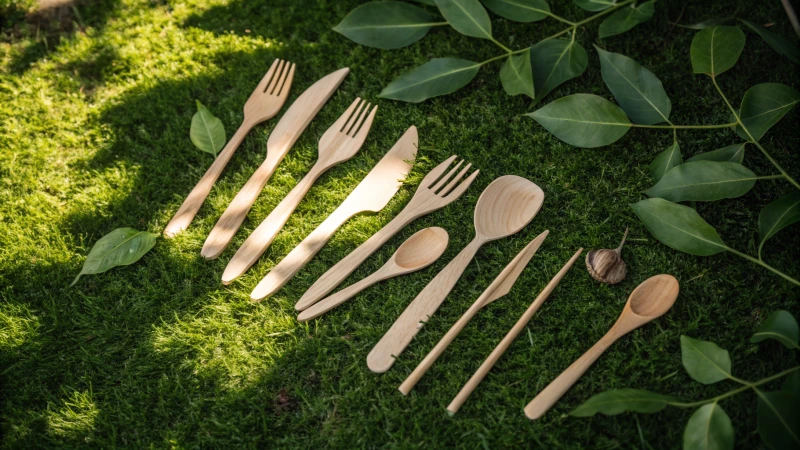
Have you ever thought about how durable an eco-friendly wooden fork is?
Disposable wooden cutlery endures from a few days to several weeks outside. It breaks down in about 90 days in compost. However, it needs months to decades to decompose in landfills. Anaerobic conditions slow down the process.
I remember hosting a barbecue in my backyard last summer. Instead of plastic utensils, I used wooden ones. It felt good knowing they wouldn't sit in a landfill for many years. Over the next weeks, I watched them change under the sun and rain. The environment affects how fast or slow they break down. Warm compost piles and dry landfills treat them differently. Weather decides their lifespan. Let's explore how these places impact wooden cutlery's decay.
Wooden cutlery decomposes faster in damp environments.True
Moisture accelerates microbial activity, leading to quicker degradation.
Composting wooden cutlery takes over a year.False
In optimal composting conditions, wooden cutlery breaks down in 90 days.
What Factors Affect the Decomposition of Wooden Cutlery?
Do you ever think about why your wooden fork breaks or stays in nature for a long time?
Wooden cutlery breaks down depending on wood type, moisture, temperature and germs. Untreated birch or bamboo decays quickly in warm, wet places. Treated wood takes longer to break down, especially in landfills.
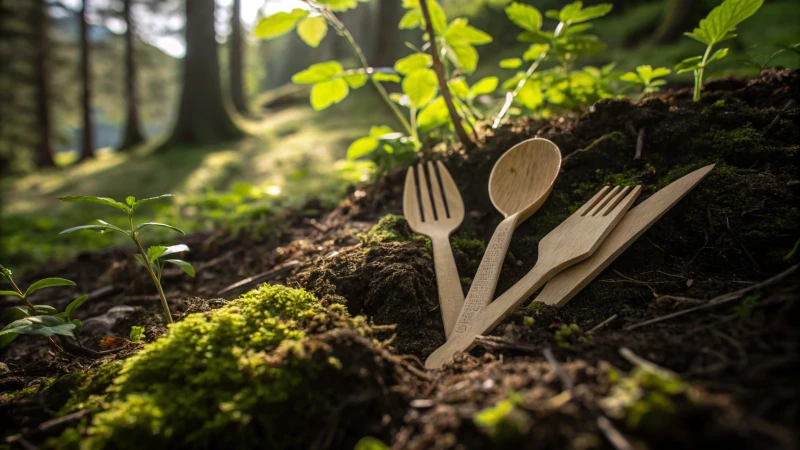
Material Quality and Type
The kind of wood really matters! Think of birch as a soft friend who lets things go easily, while bamboo stands firm. Birch has soft fibers and breaks down quickly. Bamboo takes time, but both can disappear naturally. Both are stars at breaking down due to their biodegradable properties1.
Table: Decomposition Rates by Wood Type
| Wood Type | Typical Decomposition Time |
|---|---|
| Birch | 6-12 weeks |
| Bamboo | 12-24 weeks |
Environmental Conditions
Remember leaving something out in the rain versus a dry room? Decomposition works like that. Warm, humid places help wooden cutlery break down quickly because of more microbes. Dry or cold places slow the process, like waiting for the right time.
- Moist Environments: Fungus grows and breakdown speeds up.
- Dry Conditions: It pauses, like hitting a stop button.
Treatment and Coating
Think of that shiny finish on some wooden forks. It looks nice and lasts long, but the oils or varnishes can slow decomposition. If you want to compost, choose untreated ones.
Composting vs. Landfills
Composting treats your wooden cutlery to a relaxing time - oxygen and small living things work fast to break it down in about 90 days. Landfills are like a long holiday with not much going on because they lack air.
Table: Decomposition Environment Comparison
| Environment | Decomposition Time |
|---|---|
| Composting | Up to 90 days |
| Landfill | Several months to years |
Knowing these things helps me - and maybe you too - choose wisely when throwing away wooden cutlery. Whether you're a business or someone who enjoys eco-friendly tools at home, understanding these points helps us take better care of our planet by using sustainable materials2.
Wooden cutlery decomposes faster in damp environments.True
Moisture accelerates microbial activity, leading to quicker decomposition.
Wooden cutlery decomposes quickly in landfills.False
Anaerobic conditions in landfills slow down the decomposition process.
How Does Wooden Cutlery Compare to Plastic in Terms of Longevity?
Have you ever thought about whether wooden spoons last longer than plastic ones? I will dive into the details of these common items. Discover which really endures over time.
Wooden cutlery breaks down naturally, while plastic sticks around for a long time. Plastic utensils can stay around for hundreds of years. Wooden ones usually decompose in weeks or months.
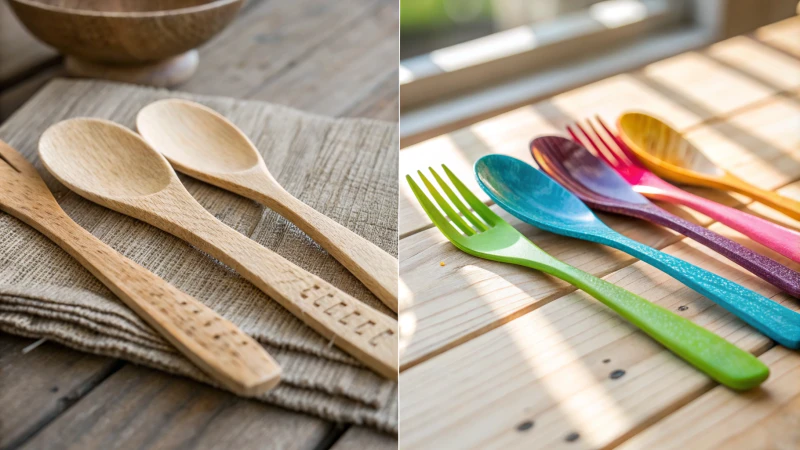
Durability and Decomposition Rates
The lifespan of something like cutlery fascinates me. When comparing wooden cutlery3 and plastic utensils, longevity is a critical factor. Wooden cutlery, generally made from birch or bamboo, has a short lifespan as it is designed to decompose quickly, offering an eco-friendly option. In contrast, plastic utensils can last for hundreds of years if not recycled.
| Material | Typical Lifespan | Decomposition Rate |
|---|---|---|
| Wooden | Weeks to months | Biodegradable within 90 days |
| Plastic | Indefinitely | Decomposition takes centuries |
Environmental Impact and Usage
The impact on our planet is significant when considering longevity. Wooden utensils suit one-time events like outdoor parties because they return to nature quickly. They are ideal for single use in situations where they can decompose naturally. In contrast, plastic utensils might be reused multiple times but often linger in landfills when not recycled properly.
Practical Applications
Imagine a picnic in the park. A wooden fork absorbs moisture from the grass and naturally breaks down over several weeks. Meanwhile, plastic cutlery4 remains unchanged unless exposed to external forces. This contrast highlights why I prefer wooden options.
Considerations for Businesses
For businesses such as restaurants and catering services, choosing between wooden and plastic cutlery goes beyond cost; it affects brand image. Wooden options signal a commitment to sustainability, attracting eco-conscious customers who care about their footprint.
Want more ideas on sustainable choices? Check our guide on eco-friendly alternatives5.
Wooden cutlery decomposes faster in damp conditions.True
Moisture accelerates microbial activity, leading to quicker decomposition.
Wooden cutlery lasts longer in landfills than in compost.True
Anaerobic landfill conditions slow down the decomposition process.
Is Wooden Cutlery Truly Compostable and Biodegradable?
Have you ever thought if the shiny wooden forks at your favorite eco-friendly café are really as environmentally friendly as they appear? Let's explore the truth about how well wooden cutlery breaks down and returns to nature.
Wooden cutlery usually decomposes and returns to nature. It breaks down more quickly than plastic materials. This helps lower waste and pollution in landfills, especially in good conditions.
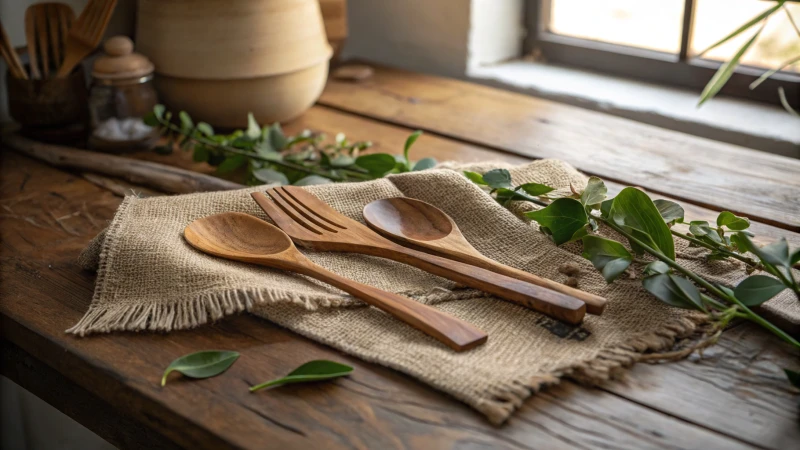
The Science Behind Compostability
Imagine a sunny afternoon picnic. You think about the waste from your disposable cutlery. Wooden utensils become important here. These utensils transform into soil since they come from birch or bamboo. They fall apart like autumn leaves. Microorganisms in a composting environment6 help them vanish in about 90 days.
Factors Affecting Biodegradability
A friend who works in sustainability once talked about how simple things can change decomposition. Warm and wet conditions quicken wooden cutlery's decay. Bamboo, for example, breaks down quickly due to its fibers.
| Factors | Impact on Decomposition |
|---|---|
| Moisture | Increases microbial activity, speeding up the process. |
| Temperature | Warmer conditions accelerate breakdown. |
| Material Quality | Untreated wood decomposes faster than treated wood. |
Environmental Considerations
Tossing a wooden fork in a landfill seems harmless, but lack of oxygen means slower breakdown. Conversely, composting creates nutrient-rich soil—it's like thanking Mother Earth.
Comparison with Other Materials
Plastic spoons linger for centuries, while wooden cutlery lasts only months when conditions are right. Compared to bioplastics7, wooden items often need fewer chemicals during production, which matters.
Potential Challenges
Not all wooden utensils are the same; coatings by some manufacturers slow decay. Reading labels for certifications is like checking for allergens—it's important.
In the end, wooden cutlery is more eco-friendly than plastics. Disposal methods and product choices affect its benefits. The next time you choose wooden forks at a café, feel good about this greener decision.
Wooden cutlery decomposes faster in damp environments.True
Moisture accelerates microbial activity, leading to quicker decomposition.
Wooden cutlery takes decades to decompose in composting conditions.False
In composting, wooden cutlery decomposes in about 90 days.
What Are the Environmental Impacts of Using Wooden Cutlery?
Do you ever think about changing your plastic forks to wooden ones? Do you wonder if it truly helps?
Wooden cutlery offers a green option because it breaks down naturally. This choice helps decrease plastic waste a lot. But the effect on nature might change based on where the wood comes from and how people throw it away. Untreated wood is usually better for the earth compared to those with plastic covers.
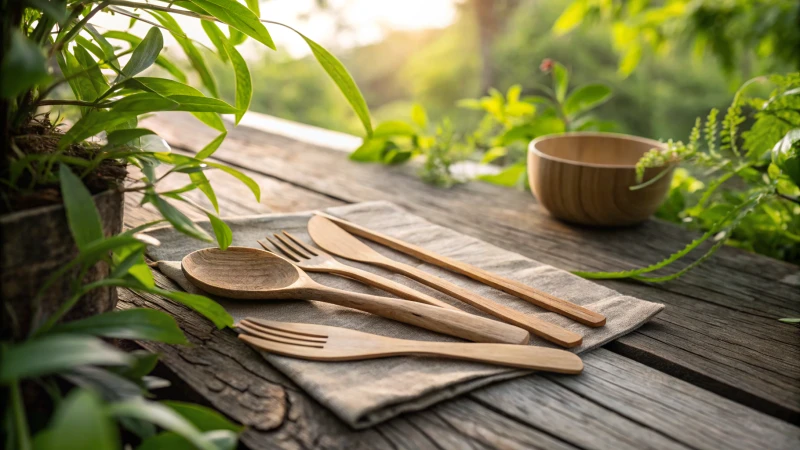
Biodegradability and Compostability
I remember my first time at a friend's picnic. Wooden forks and knives caught my eye. I wondered, "Are these really better for the planet?" My curiosity grew. I wanted to know if small actions could lead to big changes. I researched wooden utensils and here's what I found.
Wooden cutlery breaks down naturally. Plastic utensils stick around in landfills for ages, but wood ones break down in about 90 days with the right conditions. Moist places can break them down even faster, sometimes within weeks. This makes them a superb option for eco-friendly events or businesses wanting to cut down on landfill waste.
| Condition | Decomposition Rate |
|---|---|
| Damp Environments | Within a few weeks |
| Outdoor Settings | A few days to weeks |
| Composting | Approximately 90 days |
| Landfills | Several months to decades |
Source and Treatment of Wood
Not all wooden utensils are alike. Sustainability depends on whether the wood is treated or not. Untreated birch or bamboo is preferred as these woods are fast-growing and renewable. However, some have plastic coatings8 that slow breakdown, nearly ruining the purpose!
Production and Transportation Impacts
Even with better breakdown, producing wooden cutlery affects the environment. Manufacturing and shipping these items use energy and release emissions. Despite their biodegradable nature, the production process still carries environmental costs.
I now search for local suppliers to lessen these impacts, hoping my choice lowers carbon footprints.
Hygiene and Reusability Concerns
Wooden utensils look stylish and natural but they soak up moisture. I was surprised when a fork once failed me! This trait makes them less clean than metal unless cared for well.
Reusing is hard, especially in busy places like commercial settings where reusing wooden utensils can reduce demand for disposable items.
Certification and Environmental Standards
I check for labels like FSC (Forest Stewardship Council) to buy wisely. These approvals tell me the wood is from a sustainable source which matches my beliefs about protecting the planet.
To ensure environmental integrity, look for products certified by credible organizations such as eco-certifications9. These certifications help consumers make informed decisions aligned with their environmental values.
Learning these details helps me - and maybe you too - to pick wooden cutlery smartly. We want to honestly support the environment while meeting our needs.
Wooden cutlery decomposes faster in damp conditions.True
Moisture accelerates microbial activity, causing quicker decomposition.
Landfills provide optimal conditions for wooden cutlery decomposition.False
Anaerobic landfill conditions slow down the decomposition process.
Conclusion
Disposable wooden cutlery decomposes in weeks to months depending on conditions, with optimal breakdown occurring in compost within 90 days, while landfill decomposition can take years.
-
Learn about the varying decomposition rates of different woods like birch and bamboo. ↩
-
Discover why selecting sustainable materials is crucial for eco-friendly manufacturing. ↩
-
Exploring the benefits of wooden cutlery provides insight into its eco-friendly advantages and how it supports sustainability efforts. ↩
-
Understanding the longevity of plastic cutlery helps evaluate its environmental impact and potential for reuse. ↩
-
Discovering alternatives to plastic utensils can aid in transitioning to sustainable options. ↩
-
Exploring this link provides insights into how composting enhances the breakdown of wooden materials, making them more environmentally friendly. ↩
-
This link will clarify the environmental impact differences between bioplastics and wood, aiding in informed decision-making. ↩
-
Explore how plastic coatings impact the decomposition of wooden cutlery and its environmental footprint. ↩
-
Discover the importance of FSC certifications in ensuring sustainable wood sourcing for cutlery. ↩

